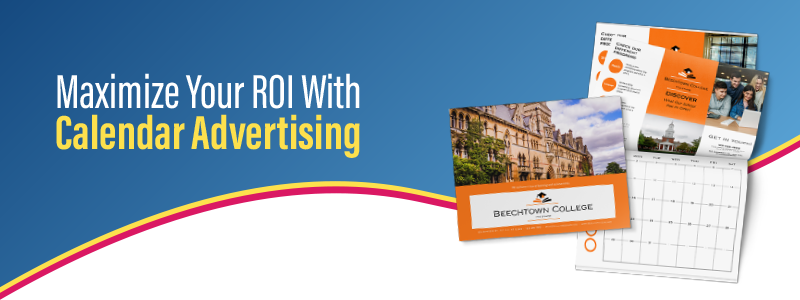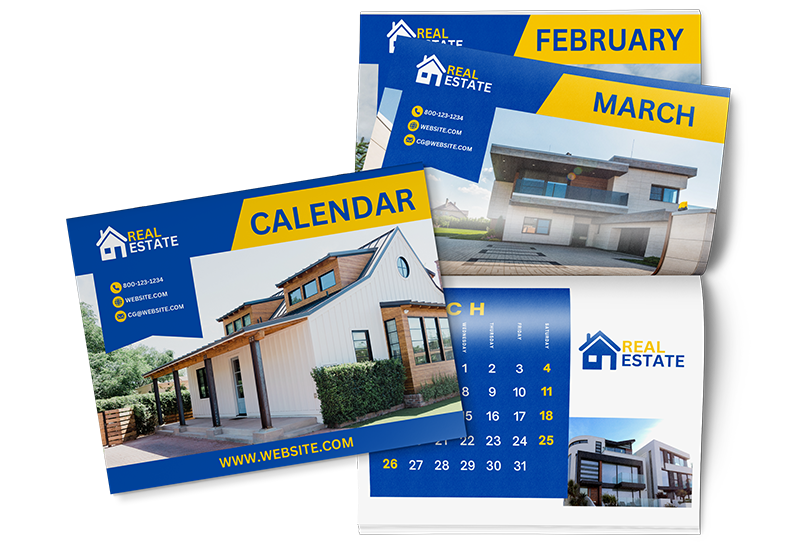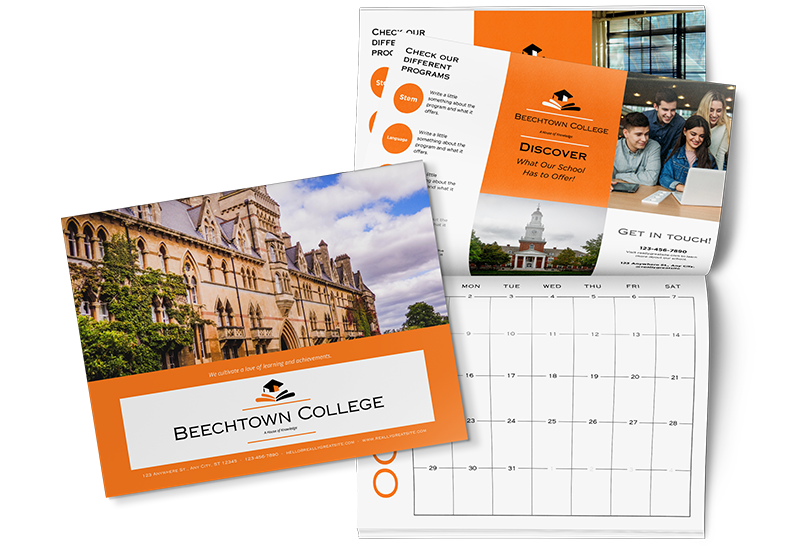
Calendars are more than just date-tracking tools. When used for advertising purposes, they transform into year-long brand ambassadors, promoting your company daily and influencing purchase decisions and brand loyalty.
In this blog, we'll go into detail on why calendars are so valuable for your brand, and we'll share eight ways you can maximize your return on investment (ROI) with calendar advertising.
The Value of Calendars in Advertising
Calendars are essential promotional tools for any business or organization. With their year-long presence, tangibility, usefulness, and affordability, they offer effective advertising opportunities every time someone checks their calendar.
.png?sfvrsn=1d6f1b8d_0)
In addition, people still enjoy physical calendars. They have fewer distractions than digital calendars, offer a stronger cognitive connection, allowing viewers to remember important dates better, and offer less stress as when someone checks their physical calendar, they aren't bombarded with email, social media, or news notifications. Because of this, calendars, in general, make a favorable advertisement by not only companies who have experienced their ROI but also by those who receive them.
So, what is the value of calendar advertising for your company? By including your logo, company information, monthly promotions, and product or service information, every time one of your calendar recipients checks their calendar, writes down a family member's birthday, or pencils in an upcoming appointment, they are reminded of your brand and exposed to what you offer. This may result in them making a purchase or contacting you right away, and it overall increases the chances that they will choose your company over your competitors when it's time for them to make a purchasing decision.
Key Strategies to Maximize Calendar Advertising
Know Your Target Audience
In order to maximize your ROI with calendar advertising, you need to know who your target audience is and distribute them effectively for maximum engagement. This is important because understanding your target audience will help you cater your design to their interests. For example, images, language, colors, and offers should all reflect who your target audience is.
First, you need to define your target audience. Are you reaching loyal, long-time customers, a new audience consisting of potential clients who share key characteristics as your most successful clients, or are you handing them out at a trade show or fundraiser? Determine what those types of people are like. What are their interests and buying activity? From there, you can make your calendar to reflect who they are so you can connect with them on a stronger level.
High-Quality Calendar Design & Content
Your calendar design and the content you include within it need to be carefully crafted in order to gain the best ROI. If your calendar isn't appealing, is overwhelming, or is missing national holidays, it's doomed for the trash bin.
Choose a theme for your calendar and stick with it. For example, a real estate company might feature luxury homes each month. A pet resort may feature images of their customer's pets, and a nonprofit might feature photos each month that share insight into their achievements in the past year. From there, make sure to keep colors, typefaces, and font sizes consistent throughout your calendar design, and write compelling advertisements to include on each page of your calendar so your audience is exposed to them each month. Keep your design professional and appealing, and include useful and valuable information that your calendar recipients can't ignore.

Content that your advertising calendar should include:
- Branding (company name, colors, logo, and slogan)
- Contact information (website URL, address, phone number, email address, social media handles)
- Compelling information about your services or products (include at least one ad each month for a specific product or service)
- Calls to action for your products or services
- Details about any monthly promotions
- Testimonials or company reviews
- Eye-catching imagery and design elements
- Special dates related to your company (anniversaries, upcoming events, or sales)
Designing a calendar takes time. You need to account for the printing design requirements and ensure that you have the proper dates, months, and holidays for the upcoming year. Because of this, you can ease and speed up the calendar designing process by taking advantage of a calendar design template. These templates already include the proper year details and printing requirements.
Incorporate Branding Effectively Throughout Your Calendar
Suppose you don't include branded elements within your calendar, such as company name, your logo, branded colors, or company slogans. In that case, your calendar isn't working as an advertisement. To keep your brand top of mind and maximize your ROI, you need to include at least your logo on every page of your calendar. This is because calendars are often left open on a given month, meaning if you only have your company name and logo on your calendar cover, you're not optimizing your brand exposure.
The goal is that whenever someone checks your calendar for the date or jots down a reminder, they are reminded of your brand, so it's essential to include your branding throughout your entire calendar.
Utilize Special Dates & Company Offers
While calendars should include the standard national holidays such as the Fourth of July, Memorial Day, and Halloween, you can enhance your calendar's effectiveness by including special events and specific dates relating to your company or organization.

For example, does your company host an annual conference, is your nonprofit hosting specific charity events or fundraisers in the upcoming year, does your business have a big sale that falls on the same week every year, is your company celebrating an anniversary or important milestone?
By including your company's special dates and offers in your custom calendar, you can better keep your audience engaged and thus increase the chances they will attend your event, contact you to learn more or make a purchase.
Making Your Calendar Interactive
Calendars are already interactive materials since recipients can hold them, flip through them, and write important reminders. However, to further enhance your advertising calendar and ensure you get the best ROI, you can make it even more interactive by including QR codes for each call to action.
QR codes enhance print advertisements by bridging the digital world with the physical. They make it faster and easier for recipients to take action, allowing them to take fewer steps to learn more or make a purchase. You can include a QR code with each call to action to maximize your ROI. For example, a retail store promoting seasonal products each month can include images of their products with a QR code that leads to the product page online, where consumers can easily place an order. A clinic could include essential health tips and appointment reminders with a QR code leading to their online patient portal where patients can quickly schedule appointments. People are more likely to take action if it is easier to do so. Rather than including a long URL that must be typed in, individuals can scan the QR code in a second. You can even have your contact information within a QR code so your calendar recipients can easily add your company information to their contacts, such as your address, website URL, phone number, and email address.
Include Calls to Action Throughout
We mention calls to action throughout this blog because you need to include a call to action with each advertisement in order to maximize your calendar advertising ROI. While each month should highlight a special offer, a specific product, or important information regarding your services, each month should also include a call to action that compels your recipients to take you up on your offer, place an order, or contact you to learn more.
For example, a local artist sending a calendar to potential clients could feature images of their work each month with a "contact me today" call to action inviting their audience to request a quote. A clothing boutique could feature images of seasonal apparel and accessories with a special promo code offering a discount during specific weeks, encouraging their audience to visit their store or make a purchase online. A lawn care company could share information regarding their services each month with tips on keeping lawns maintained with a call to action inviting their audience to contact them so they can take care of it for them.
Monitor & Track Results

Monitoring and tracking your results is essential for maximizing your ROI with calendar advertising. It allows you to measure your ROI, helps you better understand your audience, and finds ways to enhance your following calendar advertising campaign.
To track the results of your calendar, you can utilize a few strategies. Suppose your services require your audience to contact you directly. In that case, you can create a unique email address and call tracking number so that you know anyone who calls in through that number or sends an email to that specific email address is contacting you because of an ad in your calendar. You can also use QR codes with a URL containing UTM parameters. This allows you to measure how many people visited your web page by seeing how many individuals visited using the unique URL. Additionally, you can include special promos specific to your calendar ads for each offer. Every order that uses that promo code is a purchase made because of your calendar.
Time Everything Appropriately
Last but not least, timing is essential for maximizing your ROI with calendar advertising. This is because your calendar needs to get to your audience before the new year begins and before a competitor sends their calendar. A calendar that arrives at the end of January will likely be tossed compared to one that arrives in December. Additionally, suppose your competitor sends their calendar in the middle of December, and you send yours at the end of December. In that case, your audience will likely keep the one they received first, as they may have already begun filling in family birthdays and other personal reminders.
Calendars also take time to design, so it's essential that you give yourself enough time to create the calendar and proofread it thoroughly. A good rule of thumb is to plan on your audience having your physical calendar around the end of November to early December. From there, outline how long it will take you to make your calendar, find a calendar printing company who can print your calendars in a reasonable time frame, and then also give yourself a few extra days so if there are any errors with the design, you have time to fix them, and if there are any delays with shipping, you're still in the clear.
Conclusion: Maximize Your ROI with Calendar Advertising
When your audience jots down a birthday or circles an upcoming event in your calendar, they engage with your brand without the distraction of email notifications or social media pings, providing you the perfect opportunity to connect with your audience in a memorable way. When carefully designed and strategically distributed, they create a tangible bridge between your business and your audience.
From understanding who your audience is and creating a quality calendar design to incorporating interactive components and measuring your results, the above guide will help you create a calendar where every page turn promises increased ROI.
If you're interested in the power of calendar advertising, we invite you to check out our calendar printing services, where we can help you create a calendar that generates an amazing ROI. Our services don't stop at just printing, either. If you need to mail your calendars to your customers, prospects, or a new targeted audience, our in-house direct mail services have you covered.
Check Out Our Calendar Printing Services Today!









